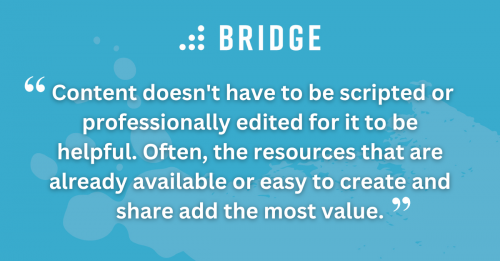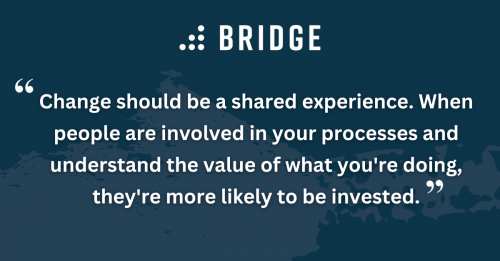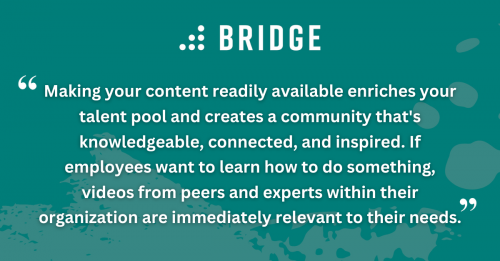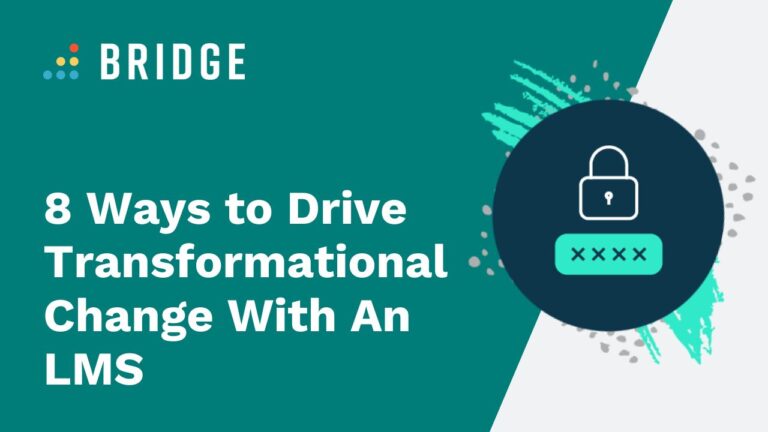60% of employees will require dedicated skills training in order to meet the demands of the next half-decade of evolving organizational needs and global change. That’s according to the World Economic Forum’s recent ‘The Future of Jobs Report’, which also suggests that 85% of leaders consider an increase in digital technology a key driver of success.
For organizations to drive transformation, digital adoption is a priority, but successful adoption of your platforms and technologies requires investment from all levels.
Overcome the Barriers to Digital Adoption With Learning and Development
Your tech exists to solve a problem, but without the proper support, that can be a challenge.
The organizations that are best prepared for the future are creating a competitive advantage by combining technology with human skills and engaging employees in training experiences supported by data, according to an AWS report.
In addition, they’re implementing the following measures to increase innovation and creativity:
- Enabling the easy exchange of information throughout teams (49%)
- Creating personalized development opportunities for employees (42%)
- Using virtual tools and technologies (34%)
A commitment to learning and development fosters innovation and collaboration, creates efficiencies and new ways of working, and shows people how to respond to challenges.
FIND OUT MORE ABOUT SMARTER GOALS | ‘What Are SMARTER Goals and How Do They Help Measure Employee Productivity?’
8 Ways to Enable Change With an LMS
To create a culture of learning that connects your people to your purpose and enables change, they need engaging experiences supported by an intuitive platform.
Here are eight ways to drive transformation and create a growth mindset with a learning management system (LMS).
1) Share the Value of New Digital Platforms
Successful technological change takes more than rolling out a new system. If the purpose isn’t clear to your people or they don’t find it adds value to their jobs, it’s unlikely to have the desired effect.
Research shows that despite an increase in investments in digital learning solutions from HR leaders, 45% of employees don’t feel that their organization’s L&D offering meets their needs.
Helping people to embrace your new platform isn’t a one-time effort, it’s a cultural shift that takes planning and time. Communicate frequently and guide them through change with support and training that demonstrates its purpose and directs efforts toward a clear objective.
Begin the cultural journey before technology training begins so your people see how this change feeds into organizational growth and what it means for them. Identify and introduce your change champions ahead of time, and share messaging to build enthusiasm and make them recognizable as your experts.

LEARN HOW TO DEVELOP YOUR PEOPLE | ‘4 Steps to Create an Employee Development Plan’
2) Enlist Help From Users
A strong learning culture is one that values gaining and sharing knowledge. Environments that enable a high level of asynchronous collaboration and sharing of organizational culture and values result in 2.4x higher levels of performance, according to Gartner.
Your people all have knowledge and expertise that can benefit others. When you encourage learners to play an active role and get involved with creating, sharing, and interacting with content, it instills a strong sense that learning and collaboration are valued within your culture.
It’s not just the people in the highest-ranking positions or the ones with the most years of experience with your company that can create great resources. What’s more important is that creators are knowledgeable and present information in a way that’s engaging, relevant, and authentic.
User-generated content doesn’t have to be scripted or professionally edited for it to be helpful. Often, the resources that are already available or easy to create and share add the most value. Informal how-to videos, recorded product demos, or casual Q&A style interviews created by the employees most familiar with your platforms and systems are valuable and compelling ways to teach people.
ENGAGE YOUR PEOPLE WITH MICROLEARNING | ‘Beating Burnout: Why Microlearning Is a Must for Time-Poor Teams’
3) Track the Right Success Metrics
Transforming your learning culture and encouraging shifts in behavior means establishing your influencers, enabling them to contribute, and giving them the tools they need to see the positive impact of their contributions.
If you want to know what content resonates with your people and what they’re engaging with, look at the relevant metrics and share this information with creators. Keep it simple and look at who’s watching videos—metrics such as the number of views, comments, shares, and likes will indicate how engaged people are with training and identify people with the most influence.
If login rates are good and people are coming to the platform but aren’t consuming your content or are dropping off, it’s a good indicator that it’s the wrong content. Additionally, look at search trends to see where any unmet needs exist.

DO MORE WITH YOUR DATA WITH THESE TIPS | ‘The Power of Learning Analytics to Drive Decisions and Growth’
4) Ask for Learner Input During Change Initiatives
Change should be a shared experience. When people are involved in your processes and understand the value of what you’re doing, they’re more likely to be invested. Findings from McKinsey show that when companies involve more than 30% of employees in capability building, returns increase by up to 40%.
If people aren’t engaging with your content, there are plenty of ways you can use analytics to connect the dots and figure out how to solve the problem. However, as valuable as the metrics are for determining adoption rates, always remember to start conversations with people and ask for opinions and feedback.
Whether discussions take the form of one-on-ones and focus groups or people prefer to share feedback through engagement surveys and course evaluations, the best experiences are inspired by the things your people care about. Learn from your people and cater your offering to meet their needs and preferences.
Content creators and subject matter experts can also reach out to their community to ask for suggestions about what training resources would be helpful. Building collaborative relationships is a great way to make people feel involved and connected.

THE IMPORTANCE OF CONVERSATION | ‘One-on-One Meetings: How the Personal Touch Improves Workplace Performance’
5) Connect Your Platforms to Avoid Digital Overload
Too many disconnected apps and systems that don’t talk to each other can hinder productivity and overwhelm your people.
Almost 40% of employees want technology to drive productivity and increase collaboration. However, research shows that employees toggle between different apps and websites up to 1,200 times a day—adding up to 5 weeks every year!
To overcome this challenge, look for ways to streamline, integrate, and maximize the efficiency of your systems to save valuable time. Your learning platforms should integrate across different systems in a way that makes the most of the technologies people are already using. This will strengthen collaboration and bring intuitive training to their flow of work.
Integrating your ecosystem also unlocks more opportunities to gather learning and performance data, where you’ll see what people are developing and how they’re using their skills.
LOOKING FOR THE RIGHT LEARNING PLATFORM? READ THIS! | ‘How to Choose an LMS for Your Organization’
6) Start Small and Be Intentional With Training
When it comes to training, everyone’s needs are different, and a blanket approach that’s too generic is unlikely to drive adoption rates. Don’t assume everyone has the same requirements, and be prepared to target your messaging to individuals and groups.
Putting specific information in front of a relevant audience, such as a specific department, level of seniority, or location, builds the momentum that keeps your learners going.
Ensuring training is relevant to a role or function keeps users from being inundated with information they don’t need and aren’t likely to use. Start small and with a specific objective in mind, then test it. From here, slowly continue to roll out content and build on success.
EXPLORE MORE WAYS TO CREATE TRAINING THAT RESONATES | ‘How Personalized Learning Enhances Employee Skills Development’
7) Make Your Content Easy to Find
A platform that puts this information in front of people serves as a central repository for people to search for information, share it with others, and create their own videos.
Making your content readily available enriches your talent pool and creates a community that’s knowledgeable, connected, and inspired. If employees want to learn how to do something, videos from peers and experts within their organization are immediately relevant to their needs.
Connecting your organization is a powerful way to establish a culture of learning, enact change, and it’s a great way to use existing content, too. Existing resources such as meeting recordings and presentations offer information in a natural, easy-to-consume format.
To instill a desire to keep learning and show your people that you’re committed to their development, keep your content library well-stocked and aligned with their needs. Tag this content with the relevant skills so learners can find relevant content that helps them achieve a goal.
RELATED READING | ‘Does Your L&D Approach Meet the Needs of Today’s Learner?’
8) Give People Time and Space to Learn
When people are busy, training can sometimes feel like another item to tick off the to-do list. Formal training sessions and lengthy courses can add pressure, leading to a lack of time spent practicing and engaging.
Give people the freedom to learn how and when they prefer, in a way that works for them. Small, spaced-out bursts of information allow people to learn a little bit at a time and work around their schedule without becoming overwhelmed or disengaged. With microlearning, your people build knowledge over time and sustain learning habits that feed into your culture.
A mobile app is a great way to stay connected to learners who work in the field or are regularly away from their desks.
HOW TO GIVE YOUR PEOPLE TIME TO LEARN | ‘Your Employees Are Busy—Here’s How to Offer Protected Learning Time’
Create a Culture of Learning With Bridge
Enable growth, collaboration, and transformation through learning with Bridge LMS. Create personalized learning experiences that develop skills, and give people the tools to share knowledge, leading to greater performance outcomes.
Bridge’s simple yet powerful learning and development platform enhances learning strategies and creates a community of connected and empowered learners.




